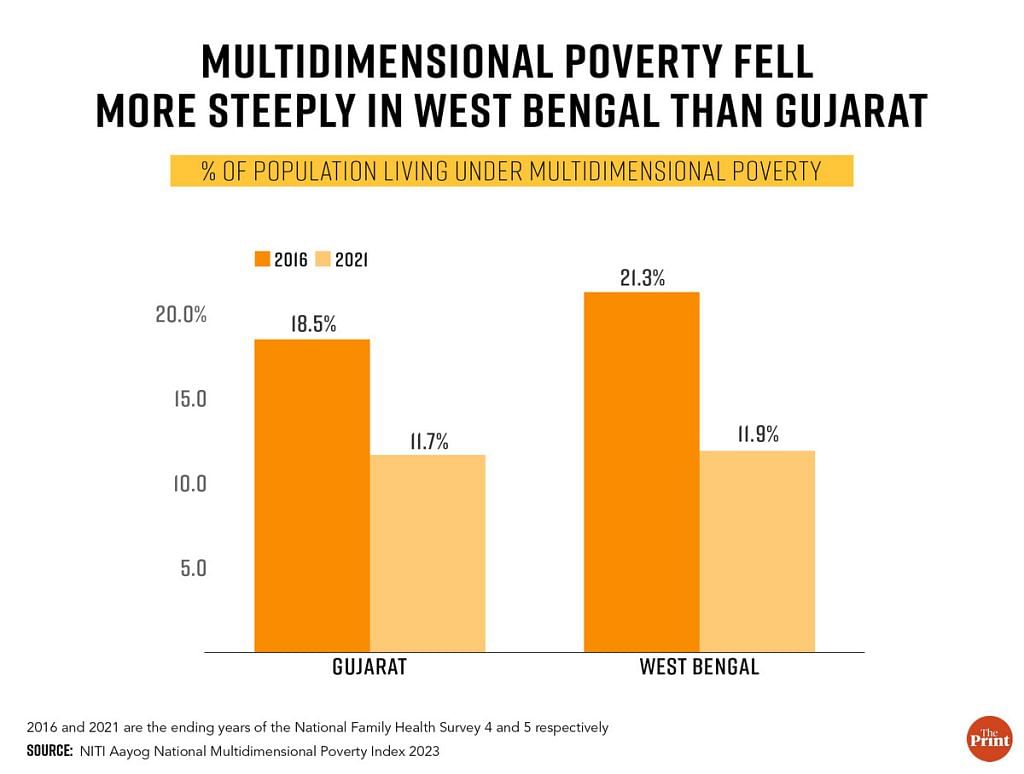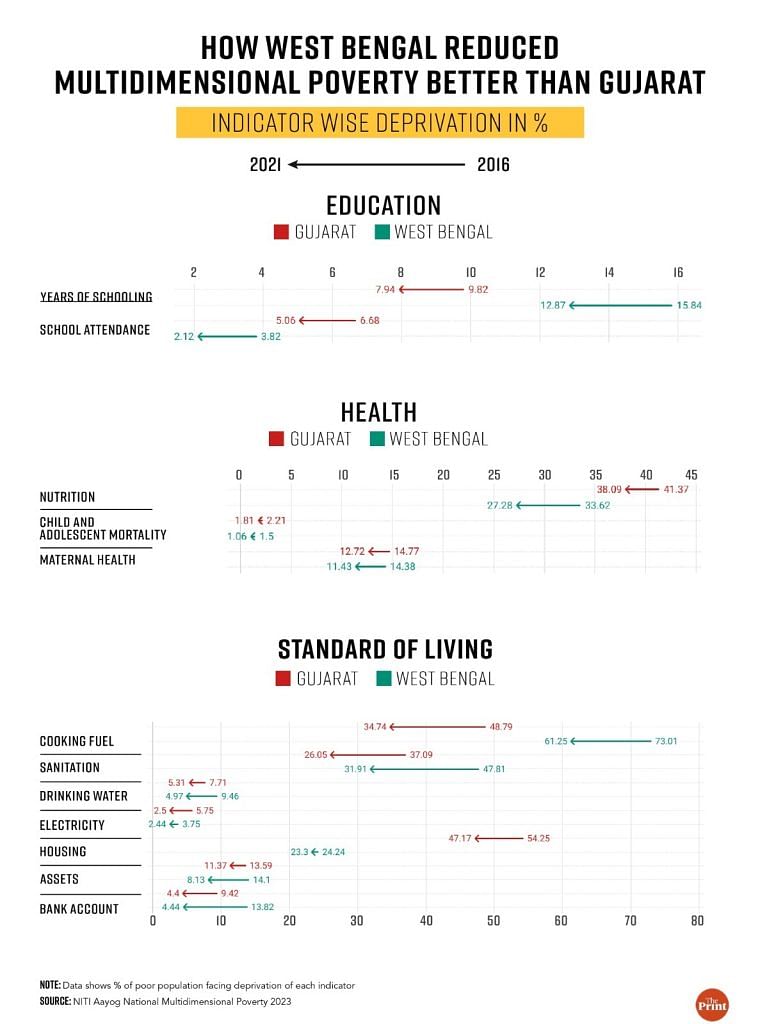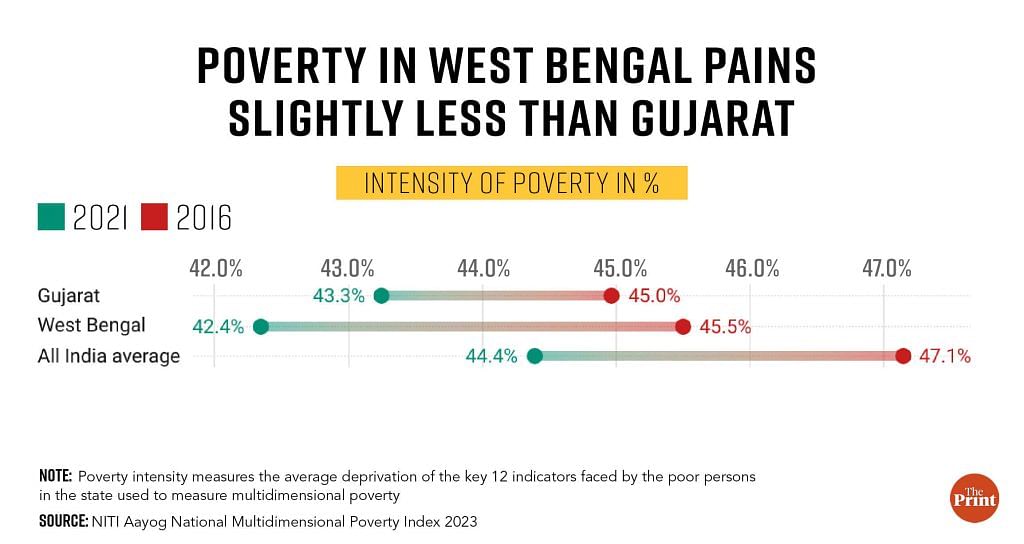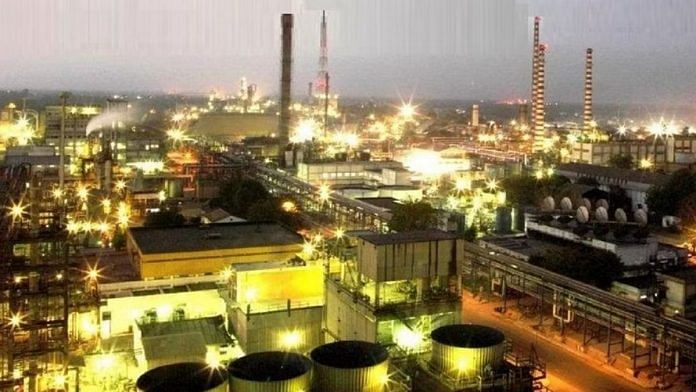New Delhi: While the “Gujarat model” is widely hailed as an “economic success story”, especially by the Bharatiya Janata Party often during elections, West Bengal is perceived as lagging behind. However, a report released this week by government think tank NITI Aayog shows that the two states have fared similarly on one unflattering metric — multidimensional poverty.
The report titled ‘National Multidimensional Poverty Index: A Progress of Review 2023′ shows that in West Bengal, 11.89 per cent of the population lives under multidimensional poverty, and the figure is only marginally lower for Gujarat at 11.66 per cent.
This is despite the fact that Gujarat’s per capita income — or average earnings of a person in a specified year — of Rs 2.5 lakh, is twice that of West Bengal’s Rs 1.24 lakh, according to the 2021-22 estimates of the Ministry of Statistics and Programme Implementation.
In spite of this income gap, West Bengal has done a better job in reducing multidimensional poverty than Gujarat over the past five years, suggests the NITI Aayog report.
To measure the trajectory of multidimensional poverty across the country, the NITI Aayog report relies on data from the last two rounds of the National Family Health Survey (NFHS), conducted in 2015-16 (NFHS-4) and 2019-21 (NFHS-5).
The report measures poverty not by the standard metric of income, but in terms of deprivation on the parameters of health, education, and standard of living, which are further divided into a total of 12 sub-indicators.
In 2016, about 18.5 per cent of people in Gujarat and 21.3 per cent in West Bengal lived under multidimensional poverty. By 2021, this population in Gujarat came down by 6.8 percentage points to about 11.7 per cent, while in West Bengal, it dropped by 9.4 percentage points, reaching 11.9 per cent.

In simpler words, about one in every 11 persons escaped poverty in West Bengal in this period, but in Gujarat, only one in every 15 people could do the same.
Given that West Bengal is more populous than Gujarat, these percentage shifts also translate to a much larger number of people escaping poverty in the former state.
In absolute numbers, from 2016 to 2021, West Bengal lifted 92.58 lakh people out of poverty, whereas the number for Gujarat was 47.84 lakh in the same period.
Also Read: Indian states with less than 10% multidimensional poverty doubled in 5 yrs, says NITI Aayog report
West Bengal outperformed Gujarat on 9 indicators
The multidimensional poverty index assesses deprivation along 12 indicators, which fall under the broader categories of health, education, and standard of living.
ThePrint conducted an in-depth analysis of all 12 indicators individually, and found that West Bengal outperformed Gujarat in reducing deprivation in nine of these.

Take nutrition, for instance. In 2016, approximately 33.6 per cent of families in West Bengal and 41.37 per cent in Gujarat had at least one member facing undernourishment.
By 2021, these numbers dropped to 27.3 per cent in West Bengal and 38.09 per cent in Gujarat.
Essentially, over this period, Gujarat saw three fewer people facing undernourishment out of every 100. But West Bengal achieved an even better outcome with six fewer people facing the same issue out of every 100.
Another example is sanitation, where deprivation is defined as an absence or lack of improvement of facilities. On this indicator, the percentage of those deprived in Gujarat went from 37 per cent to 26 per cent between 2016 and 2021 — an 11 percentage point decrease. However, West Bengal did even better in terms of an improvement, registering a 16 percentage point decrease from 47.81 per cent to 32 per cent.
In terms of access to safe drinking water within a 30-minute walking distance, West Bengal again surpassed Gujarat. It now has fewer people facing this deprivation than the western state.
About 7.7 per cent people in Gujarat and 9.46 per cent in West Bengal were deprived of clean drinking water in 2016. By 2021, this was 5.3 per cent in Gujarat and only 4.97 per cent in West Bengal.
The three indicators on which Gujarat performed better than West Bengal were housing, cooking fuel, and electricity.
‘Intensity of poverty’ greater in Gujarat
The “intensity of poverty”, according to the NITI Aayog report, refers to the average extent of deprivations experienced by all those considered multidimensionally poor.
Despite both states having a similar level of multidimensional poverty, there is a slight difference in the intensity of deprivation experienced in West Bengal and Gujarat.
In 2016, the poverty intensity in Gujarat was 44.9 per cent, and in West Bengal, it was slightly higher at 45.5 per cent.

This means that a poor individual in both states faced deprivation on about half of the indicators listed in the multidimensional poverty index.
Five years on, West Bengal fared somewhat better on this front.
By 2021, the poverty intensity in Gujarat reduced to 43.25 per cent, and in West Bengal, it decreased even further to 42.35 per cent.
This indicates that the intensity of poverty is slightly lower in West Bengal than in Gujarat.
These findings suggest that economic prosperity does not automatically alleviate multidimensional poverty. Despite experiencing high industrial growth and being a relatively developed state, Gujarat has not managed to reach the list of 14 states where less than 10 per cent of people live in multidimensional poverty.
(Edited by Asavari Singh)
Also Read: Glittering GDP, high poverty: The paradox of Karnataka’s unequal growth



